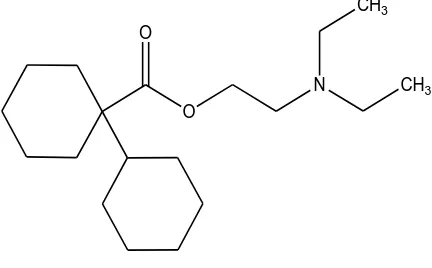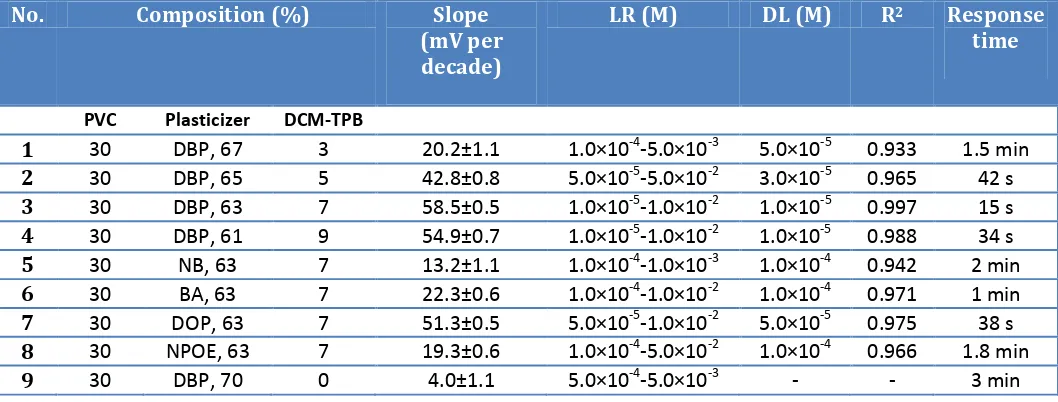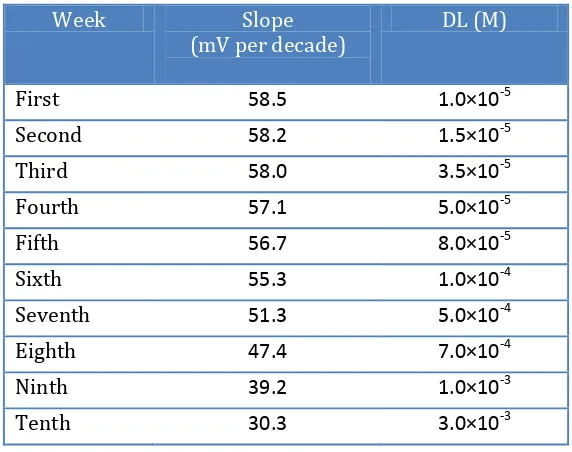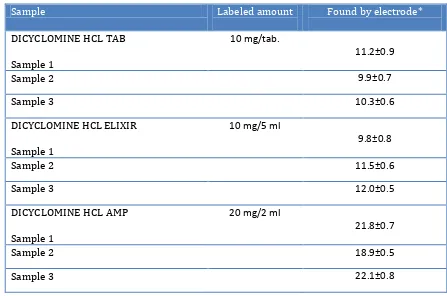Int. J. Electrochem. Sci., 7 (2012) 10404 - 10413
International Journal of
ELECTROCHEMICAL
SCIENCE
www.electrochemsci.org
PVC Membrane Sensor for Potentiometric Determination of
Dicyclomine in Pharmaceutical Formulation
Farnoush Faridbod1,2,*, Bagher Larijani,2 Mohammad Reza Ganjali1,2, Parviz Norouzi1,2 1
Center of Excellence in Electrochemistry, University of Tehran, Tehran, Iran 2
Endocrinology & Metabolism Research Center, Tehran University of Medical Sciences, Tehran, Iran *
E-mail: faridbodf@khayam.ut.ac.ir
Received: 30 September 2012 / Accepted: 19 October 2012 / Published: 1 November 2012
A simple, rapid and low-cost potentiometric method for determination of dicyclomine, anticholinergic compound, in pharmaceutical formulations is introduced. Dicyclomine-tetraphenyl borate ion-pair compound was first synthesized and then applied as a sensing element in preparation of the PVC membrane sensor. The best PVC membrane sensor response was obtained by a membrane composition of 30% PVC, 63% DBP, and 7% ion-pair. The detection limit of the sensor was obtained 1×10-5 M. The proposed sensor has a fast response time of less than 15 s. The proposed method was successfully applied in determination of dicyclomine in some pharmaceutical formulations.
Keywords: Dicyclomine, Ion-Pair, Potentiometric Sensor, PVC membrane
1. INTRODUCTION
The reported methods for determination of the Dicyclomine in pharmaceutical preparations, including microcrystallography [4], nuclear magnetic resonance techniques [5], gas-liquid chromatography [6,7], spectrophotometry [8,9] and thin-layer chromatography (TLC) [10].
O O
N CH3
[image:2.596.190.406.152.286.2]CH3
Figure 1. Chemical structure of Dicyclomine
Potentiometric using indicator electrodes have advantages of rapid and ease of preparation and procedures, fast response time, reasonable selectivity, wide linear dynamic range, and low cost. These characteristics have certainly led to the preparation of many sensors for several ionic species, and the list of available electrodes has grown largely over the past years [11-20]. PVC membrane electrodes are one of the subdivisions of potentiometric sensors which are widely used and have different application in analysis of ionic species [21-29].
In this work, the electrode works based on ion-pair which was made from the interaction between Dicyclomine and sodium tetraphenyl borate and they respond according to the ion-exchange mechanism. PVC membrane electrode was made after series of experiments.
2. EXPERIMENTAL SECTION
2.1. Apparatus
The glass cell where the DCM indicator electrode (PVC membrane) was placed; consisted of two Ag/AgCl double junction reference electrodes (Azar-Elelectrode Co., Iran) as internal and external reference electrodes. Both electrodes were connected to a Corning ion analyzer with a 250 pH/mV meter with ±0.1 mV precision.
2.2. Materials and Reagents
highest available purity without further modification. Dicyclomine hydrochloride and its pharmaceutical formulations were obtained from a local pharmaceutical manufacturer (Tehran, Iran) as gift samples.
2.3. Standard DCM solution preparation
The solubility of DCM-HCl is as follow: soluble 1 in 20 of water, 1 in 5 of ethanol, and 1 in 2 of chloroform, very slightly soluble in ether. A stock solution of 0.01 M DCM-HCl solution was prepared by dissolving the solid of DCM-HCl in distilled water. The working standard solutions (1×10-7 to 1×10-2 M) were then prepared by appropriately dilution of the stock solution with distilled water.
2.4. Preparation of the ion-pair compound
Sensing element used in the proposed sensor was an ion-pair compound made from the interaction of Dicyclomine hydrochloride and sodium tetraphenyl borate. It was prepared by mixing about 20 mL of 0.01 M acidic solution of DCM with 20 mL tetraphenyl borate solution. The resulting precipitate was then filtered, washed with distilled water and dried in room temperature [12,14].
2.5. Preparation of PVC membrane Electrodes
General procedure to prepare PVC membrane was as follow: different amounts of ion-pair along with appropriate amounts of PVC, plasticizer and additive were dissolved in tetrahydrofuran (THF), and the solution was mixed well into a glass dish of 2 cm diameter. Then, THF was evaporated slowly until an oily concentrated mixture was obtained. A plastic tube (about 3 mm o.d.) was dipped into the mixture for about 10 s so a transparent membrane of about 0.3 mm in thickness was formed. The tube was then pulled out from the mixture and kept at room temperature for about 5 h. Afterwards, the tube was filled with an internal filling solution (1.0×10-3 M of DCM-HCl solution). The electrode was finally conditioned for about 20 h by soaking in the same solution [10-12].
2.6. The emf Measurements
Following cell assembly were used for emf (electromotive force) measurements:
Ag-AgCl || internal solution, 1×10-3 M DCM-HCl solution | PVC membrane | sample solution || Ag-AgCl, KC1 (satd.)
3. RESULTS AND DISCUSSION
3.1. PVC Membrane Composition Selection
[image:4.596.34.563.317.518.2]The composition of the membrane affects on the sensor characterization and response [19-29]. Membrane composition effect on the potential responses of the electrode was tested. The operating characteristics of PVC membrane sensor can be significantly modified by changing the relative amount of the membrane components of the electrode. The main components of a membrane are PVC matrix, plasticizer and the ion-pair as a sensing material. Each membrane component plays a special role in the sensor response. Previous studies shows that the membrane prepared with a plasticizer/PVC ratio about 2.2 can show the best performance [30-35]. According to the previous studies, the optimum amount of PVC was selected 30 mg.
Table 1. Optimization of the PVC membrane ingredients
No. Composition (%) Slope (mV per decade)
LR (M) DL (M) R2 Response
time
PVC Plasticizer DCM-TPB
1 30 DBP, 67 3 20.2±1.1 1.0×10-4-5.0×10-3 5.0×10-5 0.933 1.5 min 2 30 DBP, 65 5 42.8±0.8 5.0×10-5-5.0×10-2 3.0×10-5 0.965 42 s 3 30 DBP, 63 7 58.5±0.5 1.0×10-5-1.0×10-2 1.0×10-5 0.997 15 s 4 30 DBP, 61 9 54.9±0.7 1.0×10-5-1.0×10-2 1.0×10-5 0.988 34 s 5 30 NB, 63 7 13.2±1.1 1.0×10-4-1.0×10-3 1.0×10-4 0.942 2 min 6 30 BA, 63 7 22.3±0.6 1.0×10-4-1.0×10-2 1.0×10-4 0.971 1 min 7 30 DOP, 63 7 51.3±0.5 5.0×10-5-1.0×10-2 5.0×10-5 0.975 38 s 8 30 NPOE, 63 7 19.3±0.6 1.0×10-4-5.0×10-2 1.0×10-4 0.966 1.8 min
9 30 DBP, 70 0 4.0±1.1 5.0×10-4-5.0×10-3 - - 3 min
The most important ingredient of the membrane which has the main and most effect on the selectivity of the sensor is sensing element. In this work, an ion-pair of DCM-TPB was synthesized and then applied for sensing element. 3, 5, 7 and 9 mg of DCM-TPB was tested. According to the results, 7 mg is a suitable amount.
membrane had DBP better respond. DBP among the used plasticizers provided an effective linear range and a lower detection limit due to the better extraction of DCM with Log P(octanol/water) about 3.98 (for hydrochloride form), which is a almost hydrophobic organic cation, from aqueous phase into the organic layer of the membrane. As it can be seen from Table 1, absence of ion-pair in the membrane causes a very poor response (membrane no. 9), which confirm significance of the ion-pair. The electrodes behavior show that the best Nernstian slope is 58.5±0.5 mV per decade. Finally, membrane no. 3 with the composition of 30% PVC, 7% ion-pair, and 63% DBP was the optimum one for the sensor design.
3.2. Calibration Graph and Statistical Data
The measuring range of a potentiometric sensor is the linear part of the calibration graph as shown in Figure 2.
y = -58.5x + 398.0 R² = 0.997
100 120 140 160 180 200 220 240 260 280 300
0 1
2 3
4 5
6 7
E
/m
V
-log[DCM]
Figure 2. Calibration curve of PVC membrane electrode, the results are based on 5 replicate measurements.
[image:5.596.109.465.325.636.2]
more precise determinations. Calibration graph slope for PVC membrane electrode is 58.5 mV per decade of the DCM-HCl concentration and a standard deviation of ±0.5 mV after five replicate measurements. A linear response towards the DCM concentration was from 1.0×10-5-1.0×10-2 M. In this work, detection limit of the PVC membrane sensor was 1.0×10-5 M which was calculated by extrapolating the two segments of the calibration curves.
3.3. pH Effect on the Sensor
To examine the effect of pH on the electrode responses, the potential was measured at specific concentration of the Dicyclomine solution (1.0×10-4 M) from the pH value of 1.0 up to 10.0 (concentrated NaOH or HCl solutions were employed for the pH adjustment) by PVC membrane electrode. The results showed that the potential remained constant despite the pH change in the range of 3.0 to 6.5 which indicates the applicability of this electrode in the specified pH range.
Relatively noteworthy fluctuations in the potential vs. pH behavior took place below and above the formerly stated pH limits. In detail, the fluctuations above the pH value of 6.5 might be justified by removing the positive charge on the drug molecule. Fluctuations below the pH value of 3 were caused by removal of the membrane ingredients or analyte in the solution.
3.4. Life-time Study
[image:6.596.155.441.502.728.2]Electrode lifetime was estimated by the calibration curve, periodical test of a standard solution and calculation of its response slope.
Table 3. Lifetime of PVC membrane electrode
Week Slope
(mV per decade)
DL (M)
First 58.5 1.0×10-5
Second 58.2 1.5×10-5
Third 58.0 3.5×10-5
Fourth 57.1 5.0×10-5
Fifth 56.7 8.0×10-5
Sixth 55.3 1.0×10-4
Seventh 51.3 5.0×10-4
Eighth 47.4 7.0×10-4
Ninth 39.2 1.0×10-3
Tenth 30.3 3.0×10-3
weeks utilization of PVC membrane electrode, two changes were observed: a slight gradual decrease in the slope and an increase in the detection limit. In PVC membrane electrodes after several time of usage, the membrane ingredients leak from the organic layer and affect the membrane response.
3.5. Response Time
Dynamic response time is the required time for the electrode to achieve values within ±1 mV of the final equilibrium potential, after successive immersions in the sample solutions [25-37]. Its calculation involved the variation and the recording of the DCM concentration in a series of solutions from 1.0×10-5
to 1.0×10-2 M. Sensor was able to quickly reach its equilibrium response in the whole concentration range. This time for PVC membrane electrode was less than 15 s in the solutions.
3.6. Analytical Applications
Linearity, limit of detection, recovery test, selectivity, precision, accuracy, and ruggedness/robustness were the parameters used for the method validation.
3.6.1. Selectivity study
[image:7.596.153.443.560.706.2]Selectivity, which describes an ion-selective electrode’s specificity toward the target ion in the presence of interfering ions, is the most important characteristic of these devices. The potentiometric selectivity coefficients of the Dicyclomine sensor were evaluated by the matched potential method (MPM) [38-41].
Table 4. Selectivity coefficients of various interfering compounds for Dicyclomine sensor
Interfering ion Log (KMPM)
Na+ -3.3
K+ -3.4
NH4+ -3.2
Ca2+ -3.3
Mg2+ -3.7
Cl- -3.7
NO3- -3.6
Lactose -4.1
Glucose -4.0
coefficients show that the interferences h a v e negligible effect on the performance of the electrode in an assay.
3.6.2. Recovery Test from Pharmaceutical formulations
[image:8.596.72.519.275.571.2]The proposed sensor was evaluated by measuring the drug concentration in some pharmaceutical formulations (Dicyclomine amount of some tablets) (Table 5). The drug concentration was determined using calibration method and the proposed sensor with membrane no. 3. The results are in satisfactory agreement with the labeled amounts.
Table 5. Potentiometric determination of Dicyclomine in pharmaceutical formulations
Sample Labeled amount Found by electrode*
DICYCLOMINE HCL TAB
Sample 1
10 mg/tab.
11.2±0.9
Sample 2 9.9±0.7
Sample 3 10.3±0.6
DICYCLOMINE HCL ELIXIR
Sample 1
10 mg/5 ml
9.8±0.8
Sample 2 11.5±0.6
Sample 3 12.0±0.5
DICYCLOMINE HCL AMP
Sample 1
20 mg/2 ml
21.8±0.7
Sample 2 18.9±0.5
Sample 3 22.1±0.8
* The results are based on five replicate measurements.
3.6.3. Precision and accuracy
For repeatability monitoring, 3 standard samples were measured. The RSD values by PVC membrane were not exceeding 3.7%.
3.6.4. Ruggedness/Robustness
day assays in the cited formulations performed in the same laboratory by the two analysts did not exceed 4.2%. On the other hand, the robustness was examined while the parameter values (pH of the solution and the laboratory temperature) changed slightly. Dicyclomine recovery percentages were good under most conditions, and not showing any significant change when the critical parameters were modified.
4. CONCLUSIONS
In the present work, potentiometric electrode was constructed for determination of Dicyclomine. Sensor respond based on ion-exchange mechanism. DCM-TPB was synthesized and used as sensing element in the PVC membrane. The best PVC membrane electrode performance was achieved by a membrane composition of 30% PVC, 63% DBP, and 7% DCM-TPB. The sensor showed advanced performance with a fast response time, a lower detection limit of 1.0×10-5 M for PVC membrane electrode and potential responses across the range of 1.0×10-5
-1.0×10-2 M. The sensor can determine Dicyclomine content of some pharmaceutical formulations.
ACKNOWLEDGEMENT
The authors are grateful to the Research Council of University of Tehran for the financial support of this work.
References
1. [online] Available at "Dicyclomine hydrochloride". Monograph. Drugs.com. 2. [Online] Available at http://en.wikipedia.org/wiki/Dicycloverine
3. Goodman and Gilman’s The Pharmacological Basis of Therapeutics, 7th Ed., A. G. Gilman (Ed.), Macmillan, New York, NY (1985).
4. O. N. Yalcindag and E. O. Nur, and R. Saydam, Turk. J. Tecr. Biyol. Devg., 27 (1967) 186. 5. G. M. Hanna, J. Assoc. Off. Anal. Chem., 67 (1984) 222.
6. H. S. I. Tan, Y. P. Yan and A. P. Thio, J. Chromatogr., 475 (1989) 381. 7. C. R Brownell and L. L Alber, J. Assoc. Off. Anal. Chem., 62 (1979) 1116.
8. I. L. Bebawy, M. I. Yosry and M. A. M. Kamal, J. Assoc. Off. Anal. Chem., 86 (2003) 1. 9. S. P. Oza, M. P. Dave and H. N. Vakil, Indian Drugs, 28 (1991) 198
10.P. Parimoo, M. Mounisswamy, A Bharathi and N. Lakshmi, Indian Drugs, 31, 211 (1994).
11.F. Faridbod, H. A. Zamani, M. Hosseini, M. Pirali-Hamedani, M. R. Ganjali and P. Norouzi, Int. J. Electrochem. Sci. 6 (2011) 3694-3703.
12.M. R. Ganjali, R. Nemati, F. Faridbod, P. Norouzi, and F. Darviche, Int. J. Electrochem. Sci. 3 (2008) 1288.
13.H. A. Zamani, M. R. Ganjali, P. Norouzi and M. Adib, Mater. Sci. Eng. C, 28 (2008) 157. 14.F. Faridbod, M. R. Ganjali, B. Larijani, E. Nasli-Esfahani, S. Riahi, and P. Norouzi, Int. J.
Electrochem. Sci., 5 (2010) 653.
15.S. K. Mittal, P. Kumar, S. K. Ashok Kumar, and L. F. Lindoy, Int. J. Electrochem. Sci., 5 (2010) 1984.
Electrochem. Sci., 4 (2009) 1419.
17.V. K. Gupta, R. Ludwig and S. Agarwal, Anal. Chim. Acta, 538 (2005) 213.
18.R. K. Bera, S. K. Sahoo, S. K. Mittal, and S.K.A. Kumar, Int. J. Electrochem. Sci., 5 (2010) 29. 19.M. R. Ganjali, P. Norouzi, F. S. Mirnaghi, S. Riahi and F. Faridbod, IEEE Sensors J., 7 (2007)
1138.
20.H. A. Zamani, M. R. Ganjali, P. Norouzi, A. Tadjarodi and E. Shahsavani, Mater. Sci. Eng. C, 28 (2008) 1489.
21.F. Faridbod, M. R. Ganjali, R. Dinarvand and P. Norouzi, Comb. Chem. High Throughput Scr. 10 (2007) 527.
22.M. R. Abedi, H. A. Zamani, M. R. Ganjali and P. Norouzi, Sensor Lett., 5 (2007) 516. 23.G. A. M. Mersal, and H. A. Arida, Int. J. Electrochem. Sci., 6 (2011) 1116.
24.M. R. Ganjali, Z. Memari, F. Faridbod and P. Norouzi, Int. J. Electrochem. Sci., 3 (2008) 1169. 25.M. R. Ganjali, P. Norouzi, F. Faridbod, N. Hajiabdollah, B. Larijani and Y. Hanifehpour, Anal.
Lett. 40 (2007) 2544.
26.H. A. Zamani, M. R. Ganjali, P. Norouzi, and S. Meghdadi, J. Appl. Electrochem., 37 (2007) 853. 27.V. K. Gupta, A. K. Singh and B. Gupta, Anal. Chim. Acta, 575 (2006) 198.
28.H. A. Zamani, F. Malekzadegan, and M. R. Ganjali, Anal. Chim. Acta, 28 (2008) 157.
29.M. R. Ganjali, P. Norouzi, A. Atrian, F. Faridbod, S. Meghdadi, M. Giahi, Mater. Sci. Eng. C 29 (2009) 205.
30.V. K. Gupta, R. Mangla and S. Agarwal, Electroanalysis, 14 (2002) 1127.
31.M. R. Ganjali, H. Shams, F. Faridbod, L. Hajiaghababaei, P. Norouzi, Mater. Sci. Eng. C, 29 32.(2009) 1380.
33.A. K. Jain, V. K. Gupta, L. P. Singh, P. Srivastava and J. R. Raisoni, Talanta, 65 (2005) 716. 34.H. A. Zamani, G. Rajabzadeh, M. R. Ganjali, Talanta, 72 (2007) 1093.
35.H. A. Zamani, M. R. Ganjali, P. Norouzi and S. Meghdadi, Anal. Lett., 41 (2008) 902.
36.M. R. Ganjali, H. A. Zamani, P. Norouzi, M. Adib, M. Rezapour, and M. Aceedy, Bull. Korean Chem. Soc., 26 (2005) 579.
37.M. Shamsipur, M. Yousefi, M. Hosseini, and M. R. Ganjali, Anal. Lett., 34 (2001) 2249. 38.M. R. Ganjali, P. Norouzi, F. Faridbod, S. Riahi, J. Ravanshad, J. Tashkhourian, M.
Salavati-Niasari, and M. Javaheri, IEEE Sensors J., 7 (2007) 544.
39.M. R. Ganjali, F. Faridbod, H. Rashedi, M. Hosseini and P. Norouzi, Int. J. Electrochem. Sci., 6 (2011) 2299.
40.M. R. Ganjali, F. Faridbod, B. Larijani, S. Riahi, M. Hosseini, E. Nasli-Esfahani and P. Norouzi, Int. J. Electrochem. Sci., 5 (2010) 200.
41.P. R. Buck, and E. Lindneri, Pure Appl. Chem. 66 (1994) 2527.





